Researching Game — Where Have All the Geography Majors Gone?
In this blog post, I want to report my researching on Geography games in the past week. Initially, I thought it would be very easy for me to find a couple of high-quality serious games or simulations for introduction to Geography major. Since I used quite frequently a lot of applications based on Geography – google map, Uber, Zillow (recently, I have been searching for new apartment rentals for next school year)… However, when I formally started to do the search, the difficulty was beyond my imagination. Finally, I only got a few directly related games about Geography major introduction.
Before searching, I tended to clarify the definition of Geography. With better understanding about the definition of Geography, I could trace the targeted games more accurately. I preferred the definition of Geography from the National Geography website after I compared different descriptions of “What is Geography” from different references, “Geography is the study of places and the relationships between people and their environments. Geographers explore both the physical properties of Earth’s surface and the human societies spread across it. They also examine how human culture interacts with the natural environment, and the way that locations and places can have an impact on people. Geography seeks to understand where things are found, why they are there, and how they develop and change over time(Geography, n.d.).”
Beyond the definition, I knew that as an expansive discipline, geography covers a lot of study which can always be confused with other disciplines in Environment Sciences and GeoScience. About three-quarters of graduates from the doctoral program become college professors or join college faculties(Beck, 2019). Then, based on the better understanding about what Geography as a major focuses on, I used the following platforms and methods to do the searching.
What did I find?
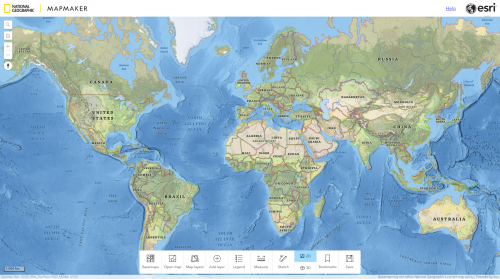
- I found this game on the website of National Geographic. I used “game” as a keyword and spotlighted the game from the search results.
- The core dynamic of this simulation is exploration. The purpose of this simulation is to invite learners to explore anywhere on the planet earth they interested in, and design a map with different layers which they want to have on the map. The different layers include many categories which can meet the designers’ personal preferences and help them understand the meaning of maps, as well as the work details of geographers.
- All ages will be welcome to use. The higer standard functions will be more suitable for high-school students and college students who are going to prefer geography as their majors.
- Geographical Adventures (Under Construction)
- https://sebastian.itch.io/geographical-adventures
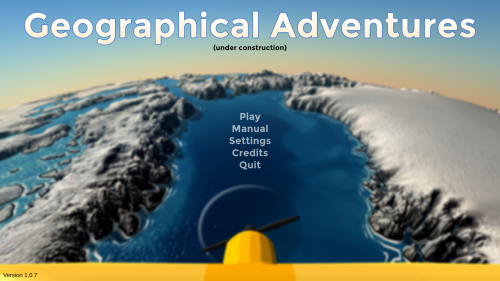
- Firstly, I found an introduction video of the game from youtube, then I trace the game on itchi.io and github.
- It is a little game under development. The Core dynamics of the game are exploration and collecting. The game rules are simple: fly around the world, picking up packages and delivering them to various cities as players go. There are three locations marked at the top of the screen. At each location, players will find a hot air balloon waiting with a package for the players to collect. Fly the plane through the balloons to collect the packages. Once the package has been picked up, its location at the top of the screen will change to a delivery address. Fly over to that city based on geography knowledge and drop the package off there.
- All ages, especially designed for the players who want to change their understanding about world map and knowledge of cities all over the world.
- NASA Earth Observations
- Website: https://neo.gsfc.nasa.gov/
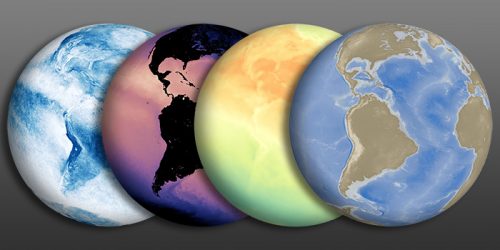
- I found this simulation from NASA website.
- The core dynamic of the simulation is exploration. Users can get visually descriptional data about energy, land, life, ocean of the world from a birdview angle, and the time bar at the bottom can show the date in different years, which are helpful to see the relative change and do comparison.
- All ages can use it, but it is more suitable for college students or graduate student who need specific data about geography.
- Mini Solar System
- Video introduction website: https://www.youtube.com/watch?v=PHnfQzlqKPg
- This is a serious game created by me.
- In Fall semester of 2023-2024, I learnt how to use OpenSimulator to creat desktop Virtual Reality project. When I used OpenSimulator to design my instructional content, I used more energy to decide which learning content I should create than thinking about what technologies I should use during my personal project. What kind of scenarios can I create in the virtual reality learning environment (VRLE) to provide the learners with a better learning experience than in the real learning environment? At that moment, a sentence sounded near my ears, “People do not learn from technology; they learn from thinking. When technologies can enhance students thinking, they should be used. Otherwise, they are probably no better than no technology.” This sentence was from David H. Jonassen, when he commented to the relationships between learning and technology during an interview(Simsek, 2012). My initial thinking for creating my VR project was a studying area contains more barriers or constraints for the learners in the real world. Both the small-sized and large-sized worlds met my assumption. E.g., a planet cell or a solar system is impossible for common learners to experience in real life, but in the VRLE, the answer is OK. Plus, in OpenSimulator, the avatar can fly to check the virtual creation from more dimensions, making it easier and more beneficial for learners who want to learn space science. Then, I created my personal VRLE, a Mini Solar System. In this serious game, players can manipulate an avantar to explore the mini solar system to better understand the location of our planet earth, then increase their interests in Geography learning.
- I believe this serious game is suitable for high-school students and college students to explore solar system in a VR setting.
What have I learned about games in my topic area?
In college, I minored in Science Education, which helped me understand the Geography was a broad major covered many study areas. According to play several games about geography, I can feel more realistically about what geography is about. But, the games and simulations I explored just covered superficial learning content, which showed a clear signal to us, the game designers to keep in mind the current gap.
There were quite a few apparent commonalities between the games. Most of the games, include many games I played but not introduced in this blog post, were related to maps. May be maps were much easier to be designed to games or simulations.
References
Geography. (n.d.). Retrieved February 8, 2024, from https://education.nationalgeographic.org/resource/geography-articleSimsek, A. (2012). Interview with David H. Jonassen: Looking at the Field of Educational Technology from Radical and Multiple Perspectives. Contemporary Educational Technology, 3(1). https://doi.org/10.30935/cedtech/6069
Read MoreAnalyzing Games and Simulations
I am writing a report on the games and simulations I have played in Module 1. I never thought that one day, I would need to play more games to finish my assignment. But it was a real learning challenge for me, especially since I needed to test the games from the angle of a game designer and researcher. Tell the difference between games, simulation games, and simulators is not easy. Among the games I played in the past week, here are the game test reports on the most impressive three games to me:
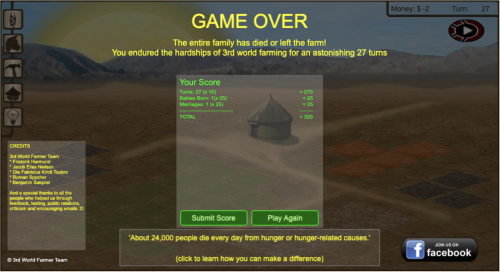
- Game/Simulation Title: 3rd World Farmer
- What was the game/simulation about?
This game shows me the real life of people in 3rd world. They have limited resources, bear diseases, are without good education, are short of medicines… Meanwhile, natural disasters like floods and droughts may be due to harvest failure. Petty thieves and corrupt officials may suddenly enhance the living burden on the people there. The player can play the role of a third-world farmer to experience their real challenges.
- Describe the game’s/simulation’s structure
- Core dynamic: Construct
- Main mechanics: progress buttons; points (wealth, health, family members population); rewards (corps harvest data); challenges (accidents and disasters); storytelling; role-playing; social interaction (the players are welcome to share the simulation results on the social medias)
- Game goal: to simulate the reality of the farms’ living in third-world countries or districts. It’s very hard for them to survive and live better.
- What did you enjoy/not enjoy while playing the game/simulation?
I felt sad while playing the game. However, I wasn’t sad because the game was badly designed but because it was well designed. It was designed so well to simulate the real challenges to the farmers in third-world countries and districts, which made me feel sad if I were one of them.
- Would you classify this as a game, simulation game, or simulation? Why?
I would classify this as a simulation since it is not for fun but for introducing farmers’ real lives in third-world countries or districts.
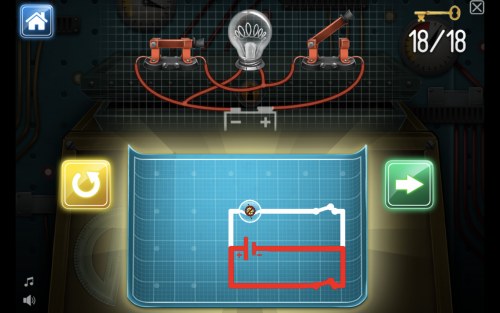
- Game/Simulation Title: Crack the Circuit
- What was the game/simulation about?
This game is about circuit knowledge. Players need to figure out the right way to link the power and terminals.
- Describe the game’s/simulation’s structure
- Core dynamic: Solution
- Main mechanics: Levels; Progress Bars (18 levels in total); Rewards (play congratulation music and sound when the player successfully figures out the circuit); Challenges; Feedback.
- Game goal: Motivate the help players learn circuit and electricity knowledge
- What did you enjoy/not enjoy while playing the game/simulation?
I enjoyed playing this simulation game because it provided me with real-time feedback about my right or wrong manipulations. It provided me with a safe environment to test my knowledge of electricity.
- Would you classify this as a game, simulation game, or simulation? Why?
I think it is a simulation game. It combines the joyfulness of the game and the meaningfulness of learning perfectly.
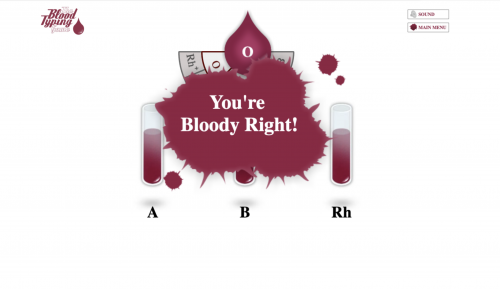
- Game/Simulation Title: The Blood Typing Game
- What was the game/simulation about?
This serious game is about learning the blood types. The player will play the role of a doctor in an emergency room to rescue a patient by starting to test the patient’s blood type. The player can learn the blood theory before playing.
- Describe the game’s/simulation’s structure
- Core dynamic: Solution
- Main mechanics: Progress bars; points; rewards (confirmation feedback); challenges (the player needs to understand the blood type theory first before successfully resolving the challenges); Storytelling; Role-playing; Feedback (error messages).
- Game goal: Motivate and help players learn blood type theory.
- What did you enjoy/not enjoy while playing the game/simulation?
I wish I had this game when I taught biology in middle school several years ago. The game visualized the different antigens in plasm and on the surfaces of different types of blood cells, which helped the players understand better the reasons behind the blood type theory.
- Would you classify this as a game, simulation game, or simulation? Why?
This is a serious game. Because it has very clear instructional aims, is built for non-entertainment, provides interesting and engaging challenges, and is designed to provide some form of skill development.
Read MoreAdvanced Design Game for Learning

I am excited to embark on my new learning journey in the Why So Serious Game Academy, facilitated by Arch McGee and supervised by Dr. Danielle Oprean. Last semester, the Design Game for Learning left a very deep impression on me. As an educator, I want to design and lead a high-efficiency online course in the future. Also, at the same time, I could imagine how much the hidden time and energy for preparing and fascilatating a course like this Dr. Oprean would cost. Beyond the skills and technologies for establishing the course, there must be uncountable passion and consideration for the learners.
In this semester, I have three different leveled expectations for my learning in this course: Advanced Design Game for Learning.
The things I must master:
- All the assignments will be finished in time.
- All the projects will be finished as required.
- All the assigned content will be reviewed.
The things I want master:
- Equip more advanced game-based learning skills.
- Link the learning content to my publishable manuscripts.
The things I may master:
- Learn how to establish a high-standard game-based online course like Advanced Designing Games for Learning.
